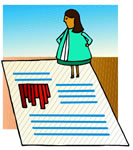 Wouldn't it be fun to hold a Poetry Slam in your school library?
Wouldn't it be fun to hold a Poetry Slam in your school library?
Aren't student volunteers a great way to get the books shelved?
Shouldn't all schools have wireless laptops available in the media center?
These are great initiatives. However before jumping into a learning activity, promotion program, or hardware purchase, you need data to support your ideas. Before you invest time and money in something that seems like a good idea, you must be certain you have data to support your decision.
![]() This section of the course contains the following related topics you'll want to investigate: Community Analysis
This section of the course contains the following related topics you'll want to investigate: Community Analysis
What is program analysis?
Program analysis is the process of focusing in on specific aspects of your program to gain an understanding of the needs, problems, and priorities.
Independent Program Analysis. In some cases, you may be able to gather the information you need on your own. For example, personal observations, circulation statistics, inventory information, and school test results are all resources that might be useful in your analysis. These resources may help you identify a need that you can address without the input of others.
Example - the teacher library observes a traffic problem at one end of the circulation desk where the laser printer and copier are located.
Collaborative Program Analysis. In many cases, it's important to conduct your analysis collaboratively with students, support staff, classroom teachers, and administration. Much of the library media program is interwoven with the entire learning community.
Example - before jumping into the development of a summer reading promotion, the library media specialist determines what classroom teachers, reading teachers, the public library, and the parent organization already have planned.
What are sources of information for program analysis?
Information from a variety of sources is needed when analyzing the program.
Community. You need to collect information from external sources. For example, what are the interests of the community? Are people into football, soccer, or sailing? Is the community rural or urban, conservative or liberal? These factors may all have a bearing on your program and collection.
Curriculum. You need to be familiar with all aspects of the approved courses of study for all curriculum areas. What are the standards? What is the emphasis of the school? How are the student test scores informing the current teaching focus?
Collection. You must know what is currently available in your local center's collection. In addition, you must be familiar with remote resources such as what's available at other school buildings in the district, the public library and in the community. The virtual collection of online resources is also part of the collection including free and subscription-based electronic materials. What's in the collection? Information about the quality and quantity of materials should be gathered, in addition to circulation and use.
Clients. You also need to examine your patrons. Who do you serve? Students, teachers, staff, administrators, and parents are all potential clients who have different roles related to the collection and program. You need to know the wants and needs of all these people. Information about the school district must also be included in your analysis. You need to know where the money comes from and who holds the purse strings.
Brainstorm ways that you could gather information in each of the categories above.
What is needs assessment?
A needs assessment is one example of program analysis.
Needs assessment is the process of collecting and analyzing information that can then be used in decision making. It's likely that you'll want to conduct needs assessments in many areas of your program.
You can conduct a formal or inform needs assessment.
What's an informal needs assessment?
Library media specialists are constantly doing simple needs assessment when they identify a problem, establish a goal, and develop a solution to fill in the gap.
What's the problem? The career books aren't current. On first glance, most have copyright dates from the 1960s and 1970s. The careers area need to be updated.
What's the goal? With seventh graders doing career exploration project, there is a need for current, timely, grade-level appropriate materials on the career topics of interest to middle school students.
What's the solution that will fill the gap? I need to collaborate with the teacher and examine what specific careers students are exploring and identify current resources to meet those needs. We need to consider a variety of resources including print, video, and web resources.
In this case, the teacher librarian assessed the current situation, identified the need, and developed a plan. Although this is a simple example, you can see how a needs assessment works. Ask yourself three questions:
What's the situation? - Where are you now? What does the situation (i.e., event, collection, staffing) look like?
Example - What do you have in your collection and is it any good? Are the materials in a particular area outdated or in poor condition? Or, are they great resources that don't seem to be used?
Where do I want to be? - Where do you want to be (i.e., successful event, quality collection, productive staff)?
Example - Do you need materials in this area? Do you get requests for these kinds of materials? Is this topic area part of the curriculum or of great interest? You may not have much on the topic of agriculture, but you may not get many requests either. On the other hand, you may have very few materials on alternative energy issues, but there is an increasing interest in the topic.
What's the solution to fill the gap? - Where are the gaps and the priorities? Is there a difference between where you are and where you'd like to be (i.e., light turnout vs heavy turnout, poor quality vs high quality materials, poor attitudes vs positive attitudes of staff)?
Example - If there's a negative gap, then you may need to do some weeding or select new materials. If there's a positive gap, you may have great materials, but no one knows they're available.
Needs assessment can be applied in all aspects of your life. Conduct your own informal needs assessment using one of the following topics:
- Examine your home. What is inefficient? What needs reorganized?
- Explore your back yard or porch. How could it be used more effectively?
- Consider your last vacation or free time activity. What is enjoyable? What would have made it more enjoyable? How can you do different the next time?
Why conduct a needs assessment?
Needs assessment helps in the development of policies, procedures, and programs. It's also useful in the selection and evaluation process. In any situation, the more information you have, the better decisions you'll be able to make about services and the collection.
Since you can't do everything, a needs assessment can help you develop priorities. You can focus on those projects that have the most immediate need or are most important. You can't help every student that walks into the center. You can't memorize every book and website in case a student have a question. You can, however, organized your time and concentrate your efforts on projects that will have an impact. For example, if it appears that many students are having difficulty finding the good books on astronomy over the bad materials, it may be time to weed the collection.
![]() Let's say students are having difficulty locating current information on hot science topics. Your time might be best spent developing a short tutorial on using the electronic databases to search for science topics. Or, creating a list of the best science magazines in your collection or great current science events websites.
Let's say students are having difficulty locating current information on hot science topics. Your time might be best spent developing a short tutorial on using the electronic databases to search for science topics. Or, creating a list of the best science magazines in your collection or great current science events websites.
If students can't get to the information in your collection, they won't use it. Curriculum development projects, teacher partnerships, and self-help materials are an important part of your school library media program.
With limited budgets and little support, you need to send your money and time wisely. A needs assessment helps you develop priorities for your spending and time.
When should a needs assessment be conducted?
 Here are some situations where you might want to conduct a needs assessment.
Here are some situations where you might want to conduct a needs assessment.
- A revised set of standards have been distributed. What programs and materials are needed to address the new standards?
- You notice that there's always a traffic jam in one area of your center. How can this area be redesigned to increase ease of movement?
- A revised subject area curriculum has been developed and the textbook committee has acquired new books. What curriculum, information inquiry approaches, and materials will support the new curriculum and textbook?
- You've gotten lots of requests for a new item (i.e., books on CD, DVD documentaries, electronic keyboards (Alphasmarts), leapfrogs). Is this something that should be included in the collection? How will it support the curriculum?
- There's not enough time to get all the book shelved. Your media clerk is overwhelmed by an increase in student enrollment. Does it make sense to use parent volunteers for this job? What about student workers?
- You've weeded a section of your library. It's really empty now. How does this area of the collection connect to the curriculum? What materials are needed to update the collection and support the curriculum?
Create a list of specific needs you've identified at your school. Or, interview a media specialist about their perceived needs and problems.
How can information be organized?
Consider what you'll do with the information you collect. You may want to generate a final report containing the following elements:
- Objective of the study
- Methodology used to collect data
- Analysis and interpretation of data
- A list of identified strengths and weaknesses
- A list of recommendations and priorities
How will information be used?
Information can be used for many purposes including decision making, policy development, and purchasing. There are many areas that benefit from quality information gathering activities:
- New programs and projects
- Policy adjustment
- Material selection
- Adjusting staffing, hours, and services
- Developing public relations programs
- Designing a professional development program
- Create a strategic plan
Make It Real
Conduct a needs assessment:
- Identify a real library media center situation.
- Describe the school audience (i.e, children, teachers, demographic information).
- Identify a goal or purpose for the survey.
- Describe the target audience for the survey.
- Develop a one-page survey for a particular set of patrons. Or, create an online survey.
- Try out the survey on at least five people.
- Tabulate the results.
- Apply the results or write a short report.
Criteria for evaluating needs assessment:
- Was a scenario provided?
- Has the audience been described?
- Is the audience and use of the survey stated and appropriate?
- Is the survey appropriate for the stated audience?
- As the directions and questions free of ambiguity?
- Are the directions and questions concise?
- Is the survey appealing and easy-to-follow?
- Is the survey professional in appearance?
- Does the survey contain measurable items that can be easily interpreted and tabulated?
- Does the survey contain information that could be used for decision-making purposes?
- Are the results of at least five "field test subjects" tabulated?
- Is a written application or report provided?